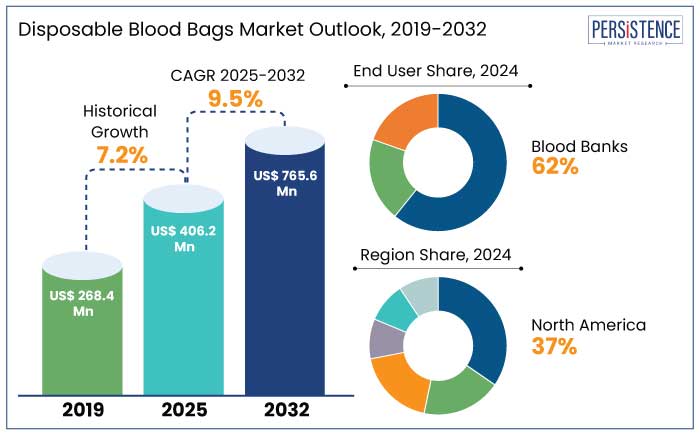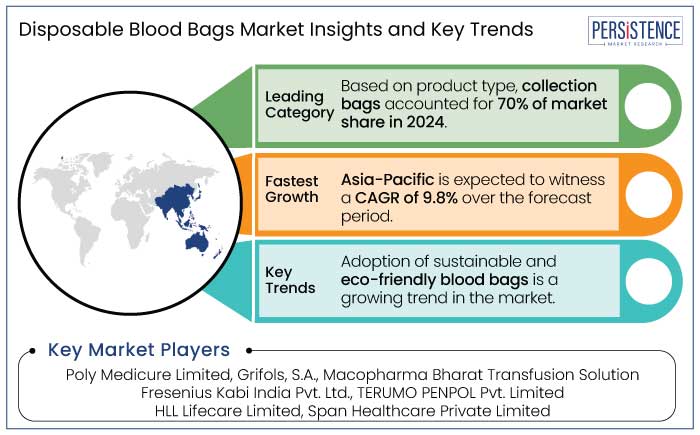Industry: Healthcare
Published Date: April-2025
Format: PPT*, PDF, EXCEL
Delivery Timelines: Contact Sales
Number of Pages: 238
Report ID: PMRREP11650
The global disposable blood bags market size is anticipated to reach a value of US$406.2 Mn in 2025 and witness a CAGR of 9.5% from 2025 to 2032. The market will likely attain a value of US$765.6 Mn in 2032.
According to the World Health Organization (WHO), globally over 118.5 million blood donations are collected every year, with demand steadily increasing due to population growth and rise in healthcare needs. Annually, over 310 million surgeries are performed worldwide with a significant portion requiring blood transfusions, propelling the demand for disposable blood bags. Leading manufacturers are shifting toward biodegradable plastics with an expected adoption rate of 15% in 2025, addressing environmental concerns.

Key Industry Highlights
|
Market Attribute |
Details |
|
Market Size (2025E) |
US$ 406.2 Mn |
|
Projected Market Value (2032F) |
US$ 765.6 Mn |
|
Global Market Growth Rate (2025 to 2032) |
9.5% CAGR |
|
Market Share of Top 5 Countries |
70.8% |
The demand for blood collection bags is anticipated to increase during the forecast period due to rising demand for blood components such as WBC, plasma, platelets, granulocytes, factor concentrates, and RBCs, in chronic conditions, and rising consumption of empty blood bags across blood derived product manufacturing companies. The incidence of rare blood disorders and the number of people with chronic anemia are predicted to increase demand for blood-derived materials, which in turn increases the demand for blood transfer bags. Accidental injury has become far more common in the past decade. Globally, around 1.3 million individuals lose their lives in traffic accidents annually, according to the Association for Safe International Road Travel.
In terms of infrastructure, the blood collection centers in African countries including Nigeria, Egypt, and Ethiopia are lagging. As a result, single blood bags are more in demand than other types in these countries. The lack of facilities for blood collection and storage results in the loss of collected blood and widens the supply-demand gap in the market. Another significant issue impeding the growth in these regions is the lack of awareness regarding voluntary blood donation efforts. One of the main barriers to voluntary blood donation across the globe is false beliefs about the donating of blood. Thus, reduced demand for blood collection bags negatively driven by the low level awareness about blood donation activities impedes the disposable blood bags market expansion.
Smart blood bags integrated with IoT (Internet of Things) sensors represent a groundbreaking leap in transfusion medicine, offering real-time visibility into the condition of stored blood during transport and storage. These next-generation bags are equipped with miniature, embedded sensors capable of continuously monitoring key metrics such as temperature, pH levels, and hemolysis indicators, factors critical to ensuring blood safety and viability.
The collected data is wirelessly transmitted to cloud platforms or mobile devices, enabling blood banks, hospitals, and logistics teams to respond immediately if thresholds are breached. For Instance, Temptime®, a subsidiary of Zebra Technologies, provides validated and widely used temperature monitoring devices for blood products, vaccines, and pharmaceuticals. These solutions are relevant in blood transportation and cold chain management and especially used by blood banks, hospitals, and mobile donation services globally.
The collection bags segment held around a 72.3% share of the total market in 2024. Blood components are collected, stored, transported, and transfused using blood collection bags. Polyvinyl chloride (PVC), a moderately rigid and brittle polymer appreciated for its non-toxicity, resilience, durability to temperature, chemical, friction, and kinking is used in the production of collection bags.
Phthalate plasticizers are introduced to PVC blood bags to soften and enhance their flexibility due to the brittleness and rigidity of PVC. These elements support the collection bag market segment's sales on the global market. Collection bags are available in various capacities (e.g., 350 mL, 450 mL, 500 mL), and collection bags are standardized for widespread use across blood banks, hospitals, and mobile donation drives. Enhanced materials with biocompatibility and extended blood storage capabilities have increased the use and reliability of collection bags.
The tender sales segment held around 60.7% share of the total market in 2024. These include the selling of disposable blood bags and government contracts, and purchases made through competitive bidding for national blood banks and government hospitals. Due to the concentrated expansion strategies of blood bag makers through a tender process and high profit margins, the tender sales channel segment is anticipated to account for significant revenue share contribution to the worldwide disposable blood bag market over the forecast period.
Based on the end-user, the disposable blood bags market is further divided into blood banks, hospitals and NGOs. Among these leading end-users, the blood banks segment owned a notable market share of 62% in 2024, while hospitals are the second leading end-user segment.
Blood banks are the primary entities for collecting, processing, and storing blood. With increasing blood donation drives and rising awareness globally, blood banks are pivotal in ensuring a stable blood supply. Blood banks handle large-scale operations, needing bulk collection bags for daily activities. Many blood banks process blood into components such as plasma, red blood cells, and platelets, with the need for collection and transfer of blood. Blood banks are at the forefront of adopting advanced blood storage and compatibility testing systems, which increases their reliance on high-quality disposable plastic blood bags.

The U.S. disposable blood bags market accounted for around 91.9% market share in North America in 2024. The industry is poised to expand due to factors including the rise in use of blood tests and the prevalence of numerous chronic diseases and blood-related disorders in the country. Increased blood donation activities equipped with health care infrastructure, and government initiatives promote the use of disposable blood bags to prevent infections are major factors that helps enlarge the medical industry.
Over 10,000 units of platelets, 40,000 units of red blood cells, and 15,000 units of plasma are required daily in the United States, according to data from the American National Red Cross that was released in 2023. In addition, in the United States, an estimated 6.8 million people donate blood each year.
The U.K. disposable blood bags market held around 35.0% of Europe in 2024. According to the U.K. Office for Health Improvement and Disparities, there are about 214,000 carriers and about 1,000 patients with thalassemia in England. The growing prevalence of thalassemia is a major factor responsible for growth. Sickle disease is the most prevalent and severe genetic disease in England. Sickle cell anemia affects one in every 2,000 newborns annually. Blood disorders are becoming more common which is expected to promote market expansion in the U.K.
China disposable blood bags market accounted for a share of about 26.7% of the Asian markets in 2024. The inappropriate usage of RBCs in medical settings has recently come to light in China, and this has a negative effect on the scarce blood supply of RBCs. The growth of the medical security system to include both rural and urban areas has greatly boosted the number and size of hospitals from all levels, especially in the light of changes in China's economy and society.
The disposable plastic blood bags market is competitive, with several global and regional players striving for market share. Terumo Corporation, Fresenius Kabi, and Macopharma lead the market, leveraging strong research and development capabilities and global distribution networks. Leading companies focus on innovating biocompatible, phthalate-free, and eco-friendly solutions to address sustainability concerns. Haemonetics Corporation and B. Braun Melsungen are notable players driving advancements in multi-bag systems for efficient blood component separation.
Regional manufacturers, particularly in Asia Pacific, are intensifying competition by offering cost-effective products tailored for emerging markets. Strategic collaborations with NGOs and government bodies for blood donation further enhances market reach. Technological advancements, sustainability initiatives, and increasing demand from underpenetrated markets shape the competitive landscape.
|
Report Attributes |
Details |
|
Historical Data/Actuals |
2019 - 2024 |
|
Forecast Period |
2025 - 2032 |
|
Market Analysis Units |
Value: US$ Mn, Volume: As applicable |
|
Geographical Coverage |
|
|
Segmental Coverage |
|
|
Competitive Analysis |
|
|
Report Highlights |
|
|
Customization and Pricing |
Available upon request |
By Product:
By Channel:
By End-User:
By Region
To know more about delivery timeline for this report Contact Sales

The global market is estimated to increase from US$ 406.2 million in 2025 to US$ 765.6 million in 2032.
Growing blood transfusion demand, rising healthcare awareness, and improved safety standards are driving the disposable blood bags industry's expansion.
The market is projected to record a CAGR of 9.5% during the forecast period from 2025 to 2032.
The leading players include Poly Medicure Limited, Grifols, S.A., Macopharma Bharat Transfusion Solution, Fresenius Kabi India Pvt. Ltd., TERUMO PENPOL Pvt. Limited and Others.
Advancements in biodegradable materials, increasing healthcare investments, and a high frequency of blood donation programs create significant market growth opportunities.